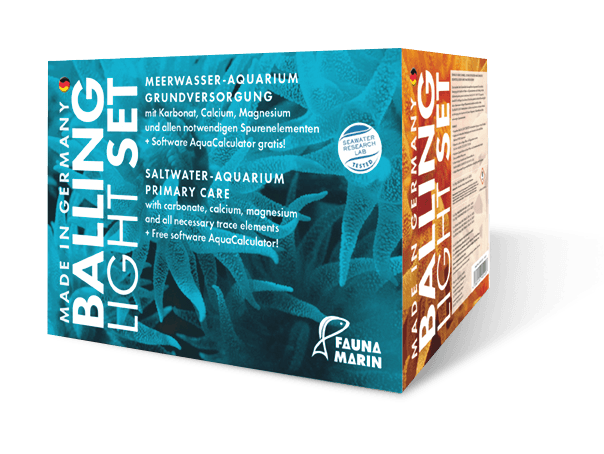Alkalinity, carbonate hardness
What’s that:
Alkalinity is an undefined sum parameter which is very important for reef aquaristics. An alkalinity test (“carbonate hardness test”, e.g. Aquahome Test KH) should be part of the basic equipment. Carbonate hardness and alkalinity are basically different. However, we use the usual term carbonate hardness.
The term „acid binding capacity“ is also used in laboratory reports. This indicates the amount of acid the water can bind, i.e. buffer. The carbonate hardness is then calculated from this value. This value alone is not meaningful, but in interaction with the salinity, calcium and magnesium, the calcium supply of the aquarium is controlled.
Problems:
A too high or too low carbonate hardness always has a direct influence on the calcium-forming elements calcium and magnesium. A stable buffer system in seawater depends on correct amounts of carbonates. Corals react quickly to too low or too high values by reducing growth or dissolving the tissue.
Measures:
A regular control and stabilization of the carbonate hardness to the recommended reference values is a basic requirement for a successful reef aquarium. The carbonate hardness should always be in the range 6.5 – 8.5 °dKH.
Value too high:
Reduce the dosage of carbonate hardness, slightly increase the calcium value and thus eliminate carbonate hardness (Caution!).
Value too low:
Increase dosage of carbonate hardness.
| Variety | general water value |
|---|---|
| Benefits | acid buffer, component of the coral skeleton |
| Reference value | reef tank with stony corals 6,5 – 7,5 °dkH reef tank with mixed coral inhabitants 7,0 – 8,0 °dkH |
| Skill Level | green |
| Source | salt mix, supply systems, trace element concentrates, feed |
| Available | Balling Light KH MIX, Elementals KH, Professional Sea Salt |
| Importance 1–6 | 6 |
| Detection quality | safe |
| Relation values | PO₄³⁻, Calcium, Magnesium, Salinität |

Balling Light:
With the BALLING LIGHT supply, the carbonate hardness is adjusted via canister 3 and the dosing quantity. Depending on the measured value, reduce or increase the dosing quantities using the consumption determination method (see Balling Light HTU) or calculate the dosing quantities using the Aquacalculator
The carbonate hardness describes the proportion of ions that consists of carbonates. These are substances that contain carbon and oxygen and consist of salts of carbonic acid. The carbonate hardness therefore only includes the alkaline mineral ions, which are present as dissolved carbonates or hydrogen carbonates. Carbonates are chemical compounds which contain carbon (C) and oxygen (O) and are salts of carbonic acid. To be considered as carbonate hardness builders, each carbonate and hydrogen carbonate ion must therefore be able to find a calcium or magnesium cation.
The carbonate hardness is measured aquaristically using drip tests. These tests determine the acid binding capacity of the water. In simple terms, the calcium contained in the water is dissolved with a strong acid. The amount of acid (number of drops) required for this indicates the amount of calcium in the water.
In sea water, this point is obtained at a pH value of 4.3. At this point, the colour of the reagent added to the acid changes. In most tests, one drop of acid per 5 ml of water = 1 dKH. This type of test is not very accurate, but it can be carried out quickly and anywhere, and for our purposes the precision is absolutely sufficient.
In the laboratory, however, professional titrators are used to determine alkalinity. Due to the different measuring methods it is quite possible that these measured values differ from the results of a droplet test.
The carbonate hardness is consumed by various processes. When setting up a new reef tank system, the carbonate hardness is mainly consumed by the build-up of biofilms and precipitation in the system which is not yet completely stable. The consumption is usually disproportionately high at this point. This is partly compensated by dissolution of decoration and substrate. Otherwise it must be compensated for by dosing with the „Balling-Light-System“. During this period of a reef tank system, it is absolutely normal to have an unbalanced consumption of carbonate hardness, calcium or magnesium. After some time the consumption will find a balance and the system will get more stable.
If artificial decoration material is used, the effect is much stronger. Modern and sophisticated systems consider these circumstances, work with highly complex organic supplements and ensure the correct dosage of the main active ingredients as well as the elements, depending on the aquarium consumption.
Tip:
In our systems we do not use organic acids or bases and no highly concentrated chemicals when dosing the carbonate hardness. Over the last 30 years, our compound has proven to be the optimum form of addition.
Highly concentrated solutions and substances that need to be converted by bacteria boost precipitation and depot effects. As a result, the proportion of precipitates increases. This promotes what is called “Old Tank Syndrome” and is the reason for many problems in maintaining reef tanks, that frequently occur after 1-2 years.